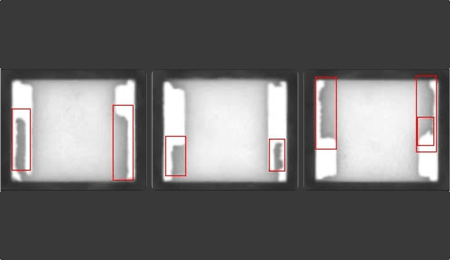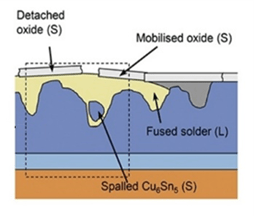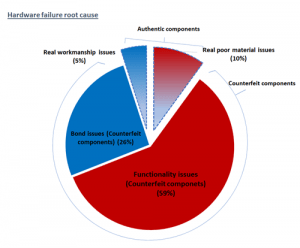The impact of counterfeit components on product reliability

Dr. Eyal Weiss, Founder Cybord

In this short article we show that the majority of electronic hardware failures (either by component fault or workmanship) originate from counterfeit components. This is because counterfeit components affect the performance of the fraudulent component as well as dramatically deteriorate the quality of its bond to the board.
Counterfeit components are everywhere. It is estimated that a few percent (some experts even say ~5%) of the components circulating in the market are counterfeit*. Premium manufacturers that utilize best supply chain practices are also vulnerable, even though to a lower extent, with average levels of 0.5-2%. For example, a board with 200 components may contain 1 to 10 counterfeit components on average.
Counterfeit components may be recycled, fore-dated or fake, and as a result may be old, poorly stored, or produced with low manufacturing standards. This deteriorates the reliability of the component and its ability to be soldered securely to the circuit board (solderability).

Figure 1
Poorly handled soldering contacts grow a thicker oxidation layer and may have a wavy surface caused by a broken inter-metallic structure (see Figure 1 where the surface buckles after simulated aging). This results in poor solder-joint reliability because the manufacturer optimizes their soldering process parameters based on an average authentic component and not considering a counterfeit one. Therefore, a counterfeit component with poor leads condition has a precarious bond regardless of the best workmanship. However, poor bond reliability is frequently misclassified as a workmanship quality issue where the true root cause is a counterfeit component.
Authentic components are not supposed to fail often. To illustrate that, our board containing 200 conventional components operating at 50°C under 50% load is expected to operate for over 2,000 years until its first component fails**. On average, about 0.15±0.05% of the assembled products are expected to fail every year. But as exemplified here, it may contain 1 to 10 counterfeit components of unknown quality, storage, handling, and solderability. Could they be responsible for a much higher industry fail rate of 1-2% compared to the theoretical 0.15%? Of course, they can. It takes only one bad component or bond to jeopardize the entire system.
If 30% of the hardware failures are related to workmanship while the root cause in most (85%) of the cases is the solderability of the component, then in fact the component itself is responsible for a larger portion of the failures. Furthermore, if 70% of hardware failures are caused by a faulty component while the authentic components failure rate is only 0.15% then much of the remaining failures are caused by un-authentic components. The conclusion is that ~85% of the hardware failure are due to counterfeit components. (See Figure 2).

Figure 2. Hardware returns an example by incorporating the counterfeit components’ poor quality and its effect on the quality of the assembly.
Employing Component Trust Analytics (CTA) on 100% of the components resolves reliability issues associated with counterfeit components that infest the electronics industry. By verifying the authenticity and solderability of the components during assembly, most of the hardware reliability issues may be avoided resulting in stable and reliable products and processes, as well as a dramatic decrease in most of the reliability-related product returns.
Dr. Eyal Weiss founded Cybord in 2018 to focus on supply chain provenance technologies, following mission failure that was due to counterfeit electronic components. Cybord’s technology performs AI-based, component level visual inspection as part of the SMT assembly process. Eyal received his B.Sc. and M.Sc in Mechanical Engineering, Plasma Physics, and his Ph.D. in Electronic and Computer Engineering.
* US Chamber of Commerce 2016; ** MIL-HDBK-217 and TDS












